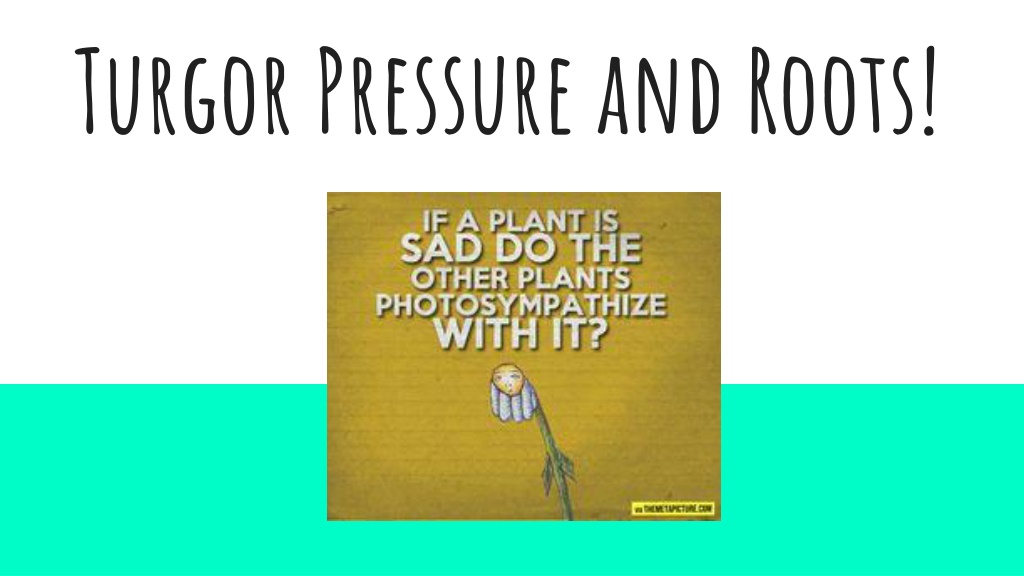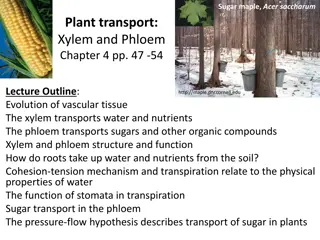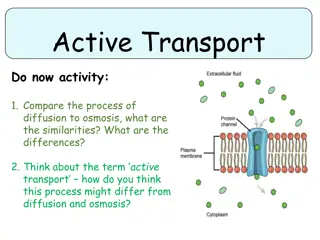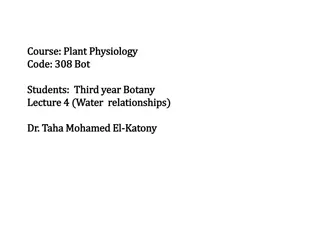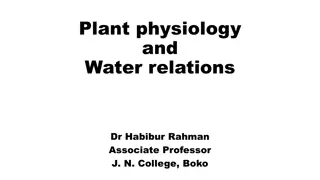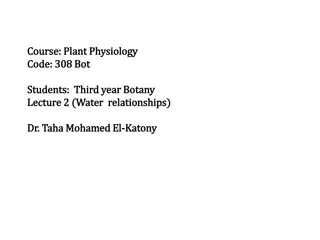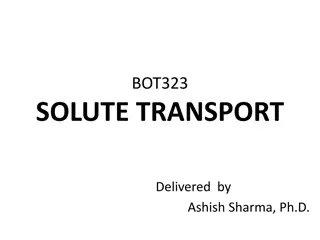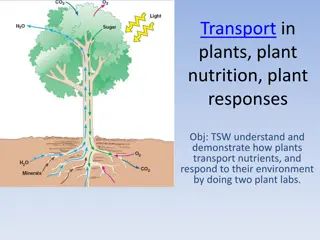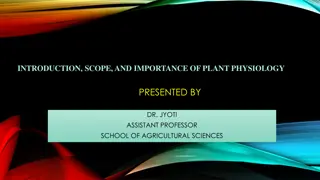Fascinating Insights into Plant Physiology and Water Transport Mechanisms
Delve into the intricate world of plant biology with discussions on osmosis, diffusion, active transport, root pressure, transpiration, cohesion, adhesion, and turgor pressure. Explore how water and nutrients are absorbed by roots, transported through xylem to the leaves, and how sugars are produced and distributed within plants. Discover the captivating Venus Flytrap's feeding mechanism and the remarkable journey of water through a tree from roots to leaves.
Download Presentation

Please find below an Image/Link to download the presentation.
The content on the website is provided AS IS for your information and personal use only. It may not be sold, licensed, or shared on other websites without obtaining consent from the author. Download presentation by click this link. If you encounter any issues during the download, it is possible that the publisher has removed the file from their server.
E N D
Presentation Transcript
Discussing our gummy worm lab How did the mass of your gummy worm change? water solution 2g salt solution 8g salt solution Why would this be?!?
Main Understandings Explain osmosis; diffusion, active transport and root pressure in root hairs Explain transpiration in plants, cohesion and adhesion as properties of water, and turgor pressure
What i think is cool about plants! Life - Venus Flytraps: Jaws of Death - BBC One About the programme: http://www.bbc.co.uk/life Hungry Venus flytraps snap shut on a host of unfortunate flies. But, despite its name, flies arent the flytrap's only meal. As long as its prey is roughly the right size and touches two of its hairs within twenty seconds, the plant will dine on any insect or spider that comes its way. Glands in the lobes then secrete enzymes that break the dinner down into a digestible soup. Ten days later, the trap pops open to reveal nothing but a dried out husk.
Remind me Think-Pair-Share Where are sugars produced in our plant? By what process? Transported by what? Where does water leave our plant?
But where does water first enter our plants?! The roots! The roots have tiny little extensions called root hairs that help absorb water and minerals! Water moves into our roots via osmosis The minerals have to be moved into the root cells against their
Water then ... Moves up towards the leaves through the xylem! What was the movement of water out of the leaves called again? Transpiration How Do Trees Transport Water from Roots to Leaves? | California Academy of Sciences Step inside the trunk of a tree to follow the path water takes from the deepest roots to the very top of a Douglas fir. Data Sources: River and Stream Data: U.S. Geological Survey, California Land Cover Spatial Data: U.S. Department of the Interior National Gap Analysis Program Video Credit: California Academy of Sciences Visualization Studio For classroom activities, visit www.calacademy.org/educators/habitat-earth-in-the-classroom - - - The California Academy of Sciences is the only place in the world with an aquarium, planetarium, natural history museum, and four-story rainforest all under one roof. Visit us online to learn more and to get tickets: http://www.calacademy.org. Connect with us! Like us on Facebook: http://bit.ly/CASonFB Follow us on Twitter: http://bit.ly/CASonTwitter Add us on Google+: http://bit.ly/CASonGoogle
Why else is water important? Turgor pressure! Water is why are stems are either firm and straight up or wilted! Turgor pressure is when water moves into our plant cell pushing the cell membrane against the cell wall. As a result, the plant is firm or turgid. When water moves out of our plant cell, the cell shrinks and wilts! What kind of solution would result in a turgid or wilted plant? Hypertonic solution Hypotonic solution
Turgor pressure also affects our guard cells When the guard cells are turgid, they open which allows gas exchange When the guard cells are flaccid or wilted, they close and reduce the amount of water loss and gas exchange.
Time lapsed turgor pressure Turgor Pressure in Celery stalks Turgor pressure due to osmosis in celery stalks
Transpiration summary The process by which water leaves the plant. Water enters the plant by the root and root hair cells Then moves up the xylem When it reaches the stomata it turns to water vapour and leaves the plant. The water leaving the plant pulls on the other water molecules by COHESION
Gas Exchange in plants In sunlight: Photosynthesis Carbon dioxide flows into the plant through the stomata to make sugars. Oxygen leaves through the stomata. When it is dark: Plants use Cellular Respiration They use the sugar they made and oxygen to produce
Woody Trees/ stems have another way! Woody trees and stems also have tissues with pores called lenticels! Allows for even more gas exchange to occur.
Questions? We will now be exploring factors that affect the rate of transpiration using an online virtual lab!
